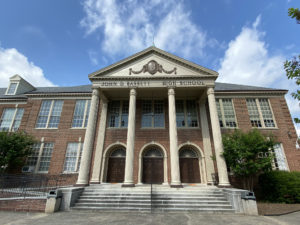The fourth week of interning with the Bassett Historical Center (6/29-7/3) was one that left plenty of room for deep thought and introspection.
Finishing Beth Macy’s book Factory Man this week, I was both sympathetic and conflicted by its overarching narrative. I was appreciative of the clear historically-backed examination of the Bassett family in the first half and an in-depth deconstruction of ‘underdog’ J.D. Bassett III vs the ‘forces’ of globalization in the second half. It certainly entertained me! However, the closeness of the novel’s subjects and people (some of whom I know) make my objectivism harder to reach. Nevertheless, I felt Macy’s treatment of the Bassett family rivalries and domestic intrigue almost cartoonishly melodramatic at times. Overall, however, the book captivated me and gives a glimpse (if only that) into the damage wrought by free trade and globalization in the area I call home.
New perspectives and insights also entertained my work at Oakwood Cemetery. As the oldest cemetery in Martinsville, Oakwood is a place of great beauty and deep history, dating back to the founding days of Martinsville and Henry County. Getting to learn a thing or two about the people buried there has made the experience even more unique. My favorite individual to learn about was Sallie Booker, one of the first women ever elected to the Virginia House of Delegates in the mid-1920s. The Democratic political leader combined years of teaching experience with suffragist advocacy to become a significant figure in Richmond’s majority-male government. Although only serving two terms, Booker’s impact in the legislative chamber earned her the trust and friendship of future governors and U.S. senators before her untimely death in 1944. Stories like this are not uncommon in most cemeteries, but I am glad to have found this one at Oakwood.
Finally, Robert Paschal’s letters are (as usual) very deep and personally touching. While Robert writes in a somewhat confusing, train of thought, almost Jack Kerouac-style, it does NOT detract from the emotive symbology of his words. For Robert to write directly what he was thinking may be, in my opinion, a unique window into the life of this early 20th-century soldier.
I hope to continue working on the Paschal letters and at Oakwood Cemetery peacefully next week, and I may perhaps begin my own reading of a history book I have long neglected to finish reading. Either way, I have high expectations for my last two full weeks interning with the Bassett Historical Center!
Pictured: John D. Bassett High School, almost directly across the road from the Bassett Historical Center. While long closed, the former school (now engagement center) remains a testament of the Bassett family’s major influence upon local life in my hometown.

